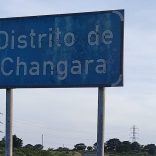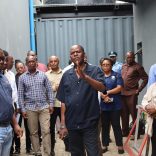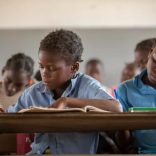Mozambique: Cholera kills six in Changara ,Tete province
Analysis: No better future on the Mozambican horizon, ten years on – By Adérito Caldeira

Image: A Verdade
The definitive results of the 2017 Census reveal that after another 10 years of Frelimo governance, a better future is not on the horizon of the majority of the 27,909,798 Mozambicans. They have in fact got poorer.
As President Filipe Nyusi said, “the numbers speak for themselves” .
The numbers show that gross domestic product per person fell, that most of the people are still peasants, more citizens are drinking water from unsafe sources, increasing numbers of people use unimproved latrines, and even illiteracy has increased.
Two years after its completion, two postponements and almost a year after the date originally planned for their release, the final results of the IV General Census of Population and Housing were finally made public on Monday (29), indicating that after all, we are not 28,861,863 Mozambicans, as preliminary results indicated, but instead 27,909,798, living here in the “Pearl of the Indian Ocean” in 2017.
Among several changes seemingly convenient for the government, the most significant was the growth rate that preliminary data put at 3.5 percent, which would be unprecedented and, according to the Professor of Economics at Eduardo Mondlane University, could represent “the turning point for a new phase of the Mozambican demographic transition”.
Fortunately, this was not confirmed. “We are at a growth rate now of 2.8 percent,” said Aarão Balate, Director General of Census and Surveys at the National Institute of Statistics (INE).

For his part, the head of state, who formally released the results shortly after 11:00 a.m. yesterday, regretted that the population continues to increase, given that it would “influence the calculation of indicators at different levels”.
“The minimum life expectancy of Mozambicans has increased … improving living conditions as a result of improved access to health and education and improved nutritional conditions for citizens. This is a reality, the numbers, as my sisters and my brothers in the statistics sector say, the numbers speak. Life expectancy in Mozambique in 1980 was 43.6 years, falling to 42.3 years in 1997 and increasing successively to 50.9 years in 2007 and with the 2017 Census life expectancy at birth rose to 53.7 years,” President Filipe Nyusi stressed.
Illiteracy rate falls but number Mozambicans who cannot read or write has increased
Nyusi also pointed out that “(…) the results of this sequence of censuses allow us to say with certainty that, for example, the illiteracy rate has been falling, from 60.5 percent in 1997 to 50.3 percent in 2007, and the 2017 Census now found that the rate is NOW 39 percent. ”

However, @Verdade found out – after analysing all of the more than 200 charts in the 2017 Census and comparing them to the respective charts for 2007 – that, although the illiteracy rate has fallen, the number of Mozambicans aged 15 and over who cannot read or write has increased from 7,102,368 to 10,502,200.
Similarly, the numbers on sanitation, critical for fighting malaria, cholera and even chronic malnutrition. The 2017 Census indicates that the access rate has improved overall, but the number of Mozambicans who still use unimproved latrines has grown from 6,395,809 to 9,759,842.

Also crucial for public health is the quality of drinking water. The 2017 Census indicates that 65.5 percent of people have access to potable water, compared to 34.5 percent in 2007. However, the 48.7 percent who consume non-safe water now constitute 51.3 percent of all Mozambicans.
The situation becomes more dramatic when looked at in detail. @Verdade established that citizens who drink non-potable water numbered 17,941,157 in 2007 while, 10 years later, that number had jumped to 20,412,291.

Gross domestic product per capita reduced
Another revelation of the 2017 Census is the fallacy of the government creating millions of jobs at a rate of more than 300,000 a year, this among the economically active population (i.e., over 15 years of age and working or actively seeking work), which grew to 8,177,386.
But 5,405,661 Mozambicans still work in the agriculture, forestry and fisheries sector, where jobs are precarious and seasonal, with the aggravating circumstance that 4,925,228 are peasants. Ten years ago the peasantry was 5,281,228. The number of domestic workers also increased from 63,013 to 487,729 people, more than half in Agriculture.

There are now 17,391,168 Mozambicans living in the countryside without secure employment, compared to 14,100,249 in 2007 – people who have been dubbed “wonderful” but who continue to live in adobe huts with grass roofs, completely vulnerable to anything like heavier rain. More than 70 percent of the homes damaged by Cyclones Idai and Kenneth are of this type.

And to prove that a better future will not reach Mozambicans any time soon, despite the fact that real gross domestic product growth has been 7 percent higher than in the last two decades surveyed, the INE census shows that the GDP per Mozambican fell from US$458 to US$453 between 2007 and 2017.

“Two important indicators influence GDP. The first is the average exchange rate and the second is average inflation rate over the last 10 years. We can grow nominal GDP, but real GDP, calculated in dollars, depends on the exchange rate,” Minister Maleiane explains.
By Adérito Caldeira
- April 30, 2019












Leave a Reply
Be the First to Comment!
You must be logged in to post a comment.
You must be logged in to post a comment.